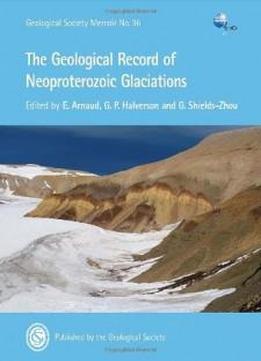
Memoir 36 - The Geological Record Of Neoproterozoic Glaciations (geological Society Memoir)
by E Arnaud /
2011 / English / PDF
32.5 MB Download
In recent years, interest in Neoproterozoic glaciations has grown
as their pivotal role in Earth system evolution has become
increasingly clear. One of the main goals of the IGCP Project
number 512 was to produce a synthesis of newly available
information on Neoproterozoic successions worldwide similar in
format to Hambrey & Harlands (1981) Earths pre Pleistocene
Glacial Record. This Memoir therefore consists of a series of
overview chapters followed by site-specific chapters. The overview
chapters cover key topics including the history of research on
Neoproterozoic glaciations, identification of glacial deposits,
chemostratigraphic techniques and datasets, palaeomagnetism,
biostratigraphy, geochronology and climate modelling. The site
specific chapters for 60 successions worldwide include reviews of
the history of research on these rocks and up-to-date syntheses of
the structural framework, tectonic setting, palaeomagnetic and
geochronological constraints, physical, biological, and chemical
stratigraphy, and descriptions of the glaciogenic and associated
strata, including economic deposits.
In recent years, interest in Neoproterozoic glaciations has grown
as their pivotal role in Earth system evolution has become
increasingly clear. One of the main goals of the IGCP Project
number 512 was to produce a synthesis of newly available
information on Neoproterozoic successions worldwide similar in
format to Hambrey & Harlands (1981) Earths pre Pleistocene
Glacial Record. This Memoir therefore consists of a series of
overview chapters followed by site-specific chapters. The overview
chapters cover key topics including the history of research on
Neoproterozoic glaciations, identification of glacial deposits,
chemostratigraphic techniques and datasets, palaeomagnetism,
biostratigraphy, geochronology and climate modelling. The site
specific chapters for 60 successions worldwide include reviews of
the history of research on these rocks and up-to-date syntheses of
the structural framework, tectonic setting, palaeomagnetic and
geochronological constraints, physical, biological, and chemical
stratigraphy, and descriptions of the glaciogenic and associated
strata, including economic deposits.
The Geological Society of London
The Geological Society of London
Founded in 1807, the Geological Society of London is the oldest
geological society in the world, and one of the largest
publishers in the Earth sciences.
Founded in 1807, the Geological Society of London is the oldest
geological society in the world, and one of the largest
publishers in the Earth sciences.
The Society publishes a wide range of high-quality peer-reviewed
titles for academics and professionals working in the
geosciences, and enjoys an enviable international reputation for
the quality of its work.
The Society publishes a wide range of high-quality peer-reviewed
titles for academics and professionals working in the
geosciences, and enjoys an enviable international reputation for
the quality of its work.
The many areas in which we publish in include:
The many areas in which we publish in include:
-Petroleum geology
-Petroleum geology
-Tectonics, structural geology and geodynamics
-Tectonics, structural geology and geodynamics
-Stratigraphy, sedimentology and paleontology
-Stratigraphy, sedimentology and paleontology
-Volcanology, magmatic studies and geochemistry
-Volcanology, magmatic studies and geochemistry
-Remote sensing
-Remote sensing
-History of geology
-History of geology
-Regional geology guides
-Regional geology guides











